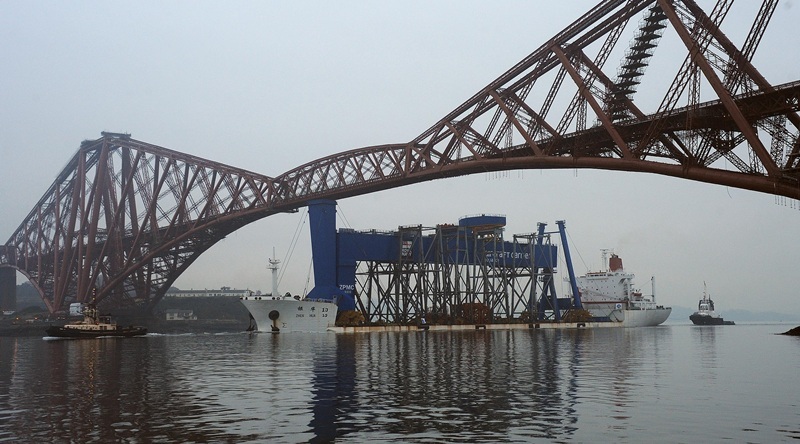The UK’s largest crane arrived at Rosyth dockyard yesterday where it will dominate the west Fife skyline after passing under the famous Forth bridges but only just.
Once commissioned, the £12.2 million Goliath crane, which is taller than the Wallace Monument, will play a vital role in the assembly of the Royal Navy’s Queen Elizabeth Class aircraft carrier at the west Fife site.
The crane, which is 68 metres high and has a span of 120 metres, made its passage up the Firth of Forth yesterday at low tide as it squeezed under the Forth bridges with only two metres to spare. Sean Donaldson, Babcock’s project director for the aircraft carriers’ construction, said he had a “knot” in his stomach.
“We knew what the safety limits were so we would have waited if the tide was higher,” he said. “We had used computer simulations beforehand to prepare for this.”
The specialist crane transport vessel on which the Goliath crane has been transported on a 14,000 nautical mile journey from China has a beam of 39 metres and overall length of 244 metres.
The Goliath crane left its construction site in Shanghai on December 17. It passed underneath the Forth bridges at 7.30am and dropped anchor just west of Babcock’s Rosyth dockyard soon after. Its voyage will end when it berths at its new home at the dockyard.
The crane’s span will cover the construction area of the carriers. It has the capacity to lift 1000 tonnes and has been two years in construction by Shanghai Zhenhua Port Machinery (ZPMC).
Mr Donaldson described the event as “a major landmark.” “After watching the Goliath crane being fabricated, it was fantastic to see it coming under the Forth bridges and I look forward to welcoming it to its new home in Rosyth,” he said. “The Goliath crane is an essential element in Babcock’s commitment to completing the assembly of the HMS Queen Elizabeth and the HMS Prince of Wales.”
And Aircraft Carrier Alliance programme director Geoff Searle added, “This is yet another important milestone for the Aircraft Carrier Alliance. The Goliath crane will be the largest structure of its type in Europe and will dominate the skyline in Fife.
“The crane is a vital element in the programme to build both the QE Class aircraft carriers because the ships are being constructed in such huge sections, so we needed something capable of lifting up to 1000 tonnes. It will be great to see the crane in action as blocks of the ship start to arrive in Rosyth in the months to come and HMS Queen Elizabeth starts to take shape.”
Barry Colford, Forth Road Bridge’s chief engineer and bridgemaster, said, “We’d been liaising closely with Babcock and Forth Ports for a number of months in preparation for the Goliath crane passing under the bridge. Clearance room, bridge loading and tides had been checked carefully and our under-deck maintenance gantry had been moved out of the way. Everything went as planned when the vessel arrived this morning.”
The Goliath crane was ordered by Babcock as an integral part of the company’s commitment to completing the assembly of the aircraft carriers, the component parts of which are being constructed at yards across the UK. The construction and material integrity has been overseen by specialists from Babcock, Lloyds Register Asia, IMES, Oceaneering and Bureau Veritas China.
The crane has been delivered partially erected, with the girder and upper sections of the legs already assembled and, upon arrival at Rosyth, it will be erected to its full height on the ship deck over six weeks, before being winched from ship to shore directly on to the crane rails.
These rails were installed last year (completed in February 2010), involving a total of 380 piles through varying ground conditions into the underlying bedrock, followed by reinforced concrete foundation beams, and the rail track. It will take just over four months to erect, test and commission the crane for handover in the summer, ensuring it will be ready for work in September.
